Custom Vendor Portal Development: Guide for Business
Vendor portal development solves some of the most critical challenges in the supply chain. It gives better visibility in your operations, speeds up procurement, and helps better manage risks, delays and loss of suppliers. As a result, you get a more resilient supply chain.
“Given today’s volatile and disruptive environment, supply chain organizations must become more flexible, and the solution is digitalization.” Dwight Klappich, VP Analyst at Gartner.
But finding the right vendor management solution, let alone building one from scratch, requires resources and expertise. In this guide, we will walk you through the main steps of developing a supplier portal and talk about the advantages of a custom solution over ready-made portals. We will also share a few expert tips on how to build a vendor portal without stretching your budget and make sure it precisely fits your business needs and scale.
A vendor portal (supplier portal) is an online space where you and your vendors/suppliers manage orders and collaborate. It simplifies vendor onboarding and management, automating routine operations such as purchase orders, bidding, and invoicing. More so, it provides 360-degree visibility into supplier relations.
Emerging and maturing supply chain technology is a major source of competitive advantage. Source: Gartner.
Vendor portals offer a wide range of benefits to every player in the supply chain across various industries — manufacturing, retail, logistics, healthcare, etc.
Benefits for your business
- Automate and speed up order management.
- Provide a 360-degree view of procurement operations (track orders, shipping, payments, performance) and entire supply chain.
- Onboard new vendors and diversify vendor portfolio to reduce the risks of broken links.
- Make data-driven purchasing decisions and planning.
- Avoid delays and provide better customer experience.
Benefits for your vendors
- Register and set up portfolio in minutes using.
- Automatically receive and process orders, enhance collaboration with clients.
- Keep and track all documentation in one place.
- Cut down on paperwork and manual work.
- Reduce operating costs and inventory time.
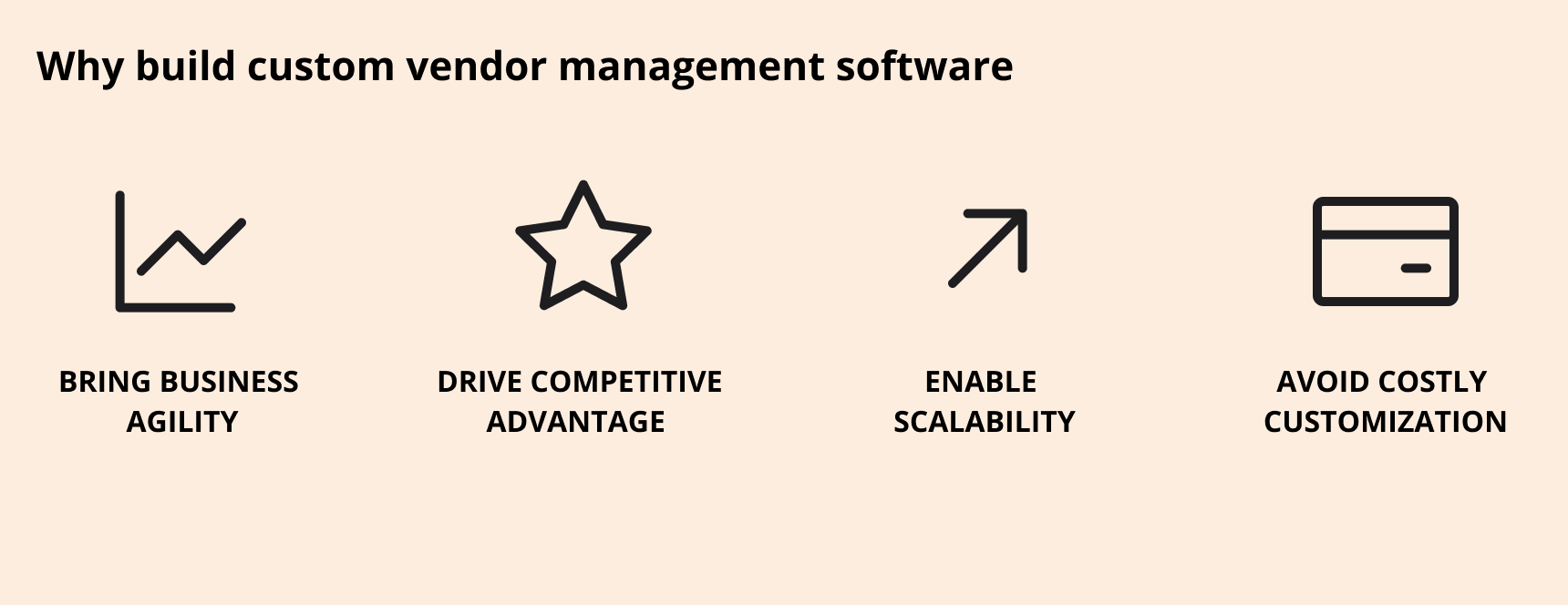
There are two major approaches to vendor portal development: platform-based and custom development. Each approach has its benefits and drawbacks and requires different resources to implement. The choice depends largely on the unique needs and scale of your business.
You can choose to integrate vendor portal into your operations using existing platforms (Salesforce, Dynamics 365) with the aim to reduce development costs. This is a viable approach for companies looking for minimal customization and standard functionality. In this case, it’s essential to find a platform that fits your scale, which we will be talking about later in the post.
However, if the core features of your portal go beyond the standard capabilities of a ready-made platform, it makes sense to build your own vendor portal. It will help you avoid costly customization that may require even more resources and time compared to custom web portal development. Most importantly, it will give you more space and agility to add new modules, unique components, and features that will build up your competitive advantage.
| Platform-based | Custom | |
|---|---|---|
| Focus | Category/niche | Your business |
| Functionality | Standard/typical tasks | Unique to your business |
| Flexibility | Limited | Unlimited |
| Customization | Limited | Unlimited |
| Integrations | Limited | Unlimited |
| Time to market | Fast | 3-6 months to MVP |
| Upfront cost | Low | High |
| Long-term cost | High | Medium to low |
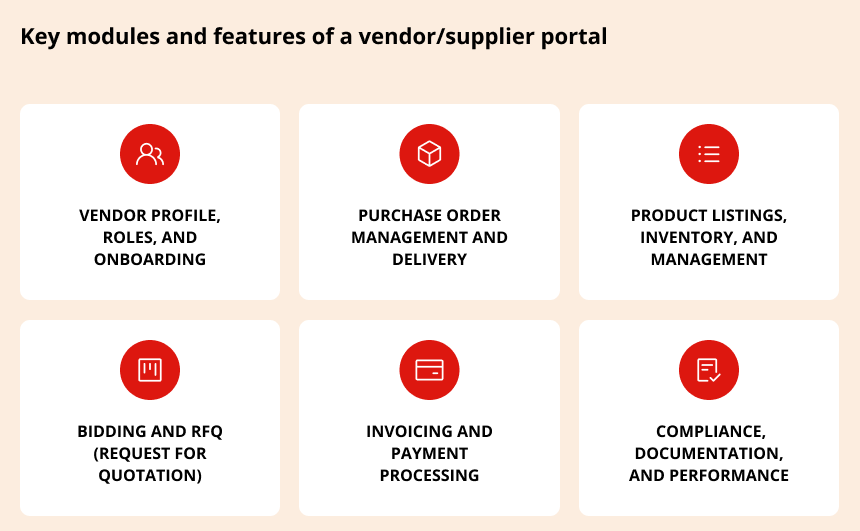
Perhaps the biggest benefit of creating your own vendor portal is the freedom to design and build features based on your business needs and priorities. You can perfectly match portal functionality with the unique workflows of your supplier management process. Moreover, you can improve and better structure your workflows by adding useful features to your portal.
Even though the scope and requirements for your vendor portal depend on the needs of your business, there are several common modules and features that you may want to consider.
Vendor profile, roles, and onboarding
Allowing vendors to create and fill in profiles, assign roles, and go through verification process online simplifies and speeds up the onboarding process. This means quicker access to quality suppliers, reduced administrative tasks, and procurement flexibility. Plus, you gain a complete vendor overview at a glance.
Purchase order management and automation
Order automation is probably the reason why you create a vendor portal in the first place. This includes automated purchase order placement, order managment and tracking, and delivery updates. It gives visibility and control over the entire fulfillment process, reduces delays, and ensures seamless operations.
Product listings, inventory, and management
Dynamic product catalogs and real-time inventory updates reduce errors and improve precision. Vendors list, update, and organize products effortlessly, while buyers browse updated inventories knowing exactly what’s in stock and what’s not. These features work best when supply chain data is integrated throughout product management and inventory systems.
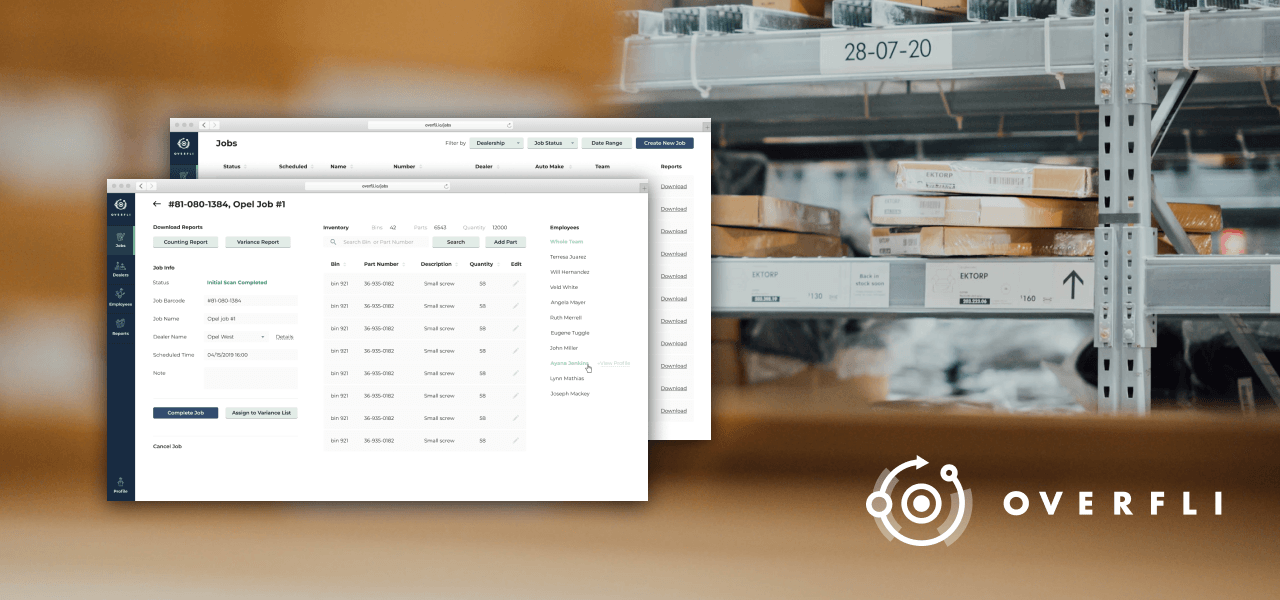
Overfli inventory management platform shows inventory data updates in real time.
Bidding and RFQ management
Some vendor management portal types include bidding automation enabling vendors to quickly respond to RFQs online and speed up procurement. These features help buyers and vendors cut time to deal, promote competitive pricing, and remove unnecessary back-and-forth.
Invoicing and payment processing
Automated invoicing, payment processing, and tracking are essential features. They help simplify accounting while keeping payments timely, secure, and transparent.
Compliance, documentation, and performance
Vendor compliance checks, certification updates, document management, and verifications are intensive and time-consuming. Moving these workflows along with vendor performance monitoring online helps you reduce compliance risks, keep a quality supplier portfolio, and gain end-to-end supply chain visibility.
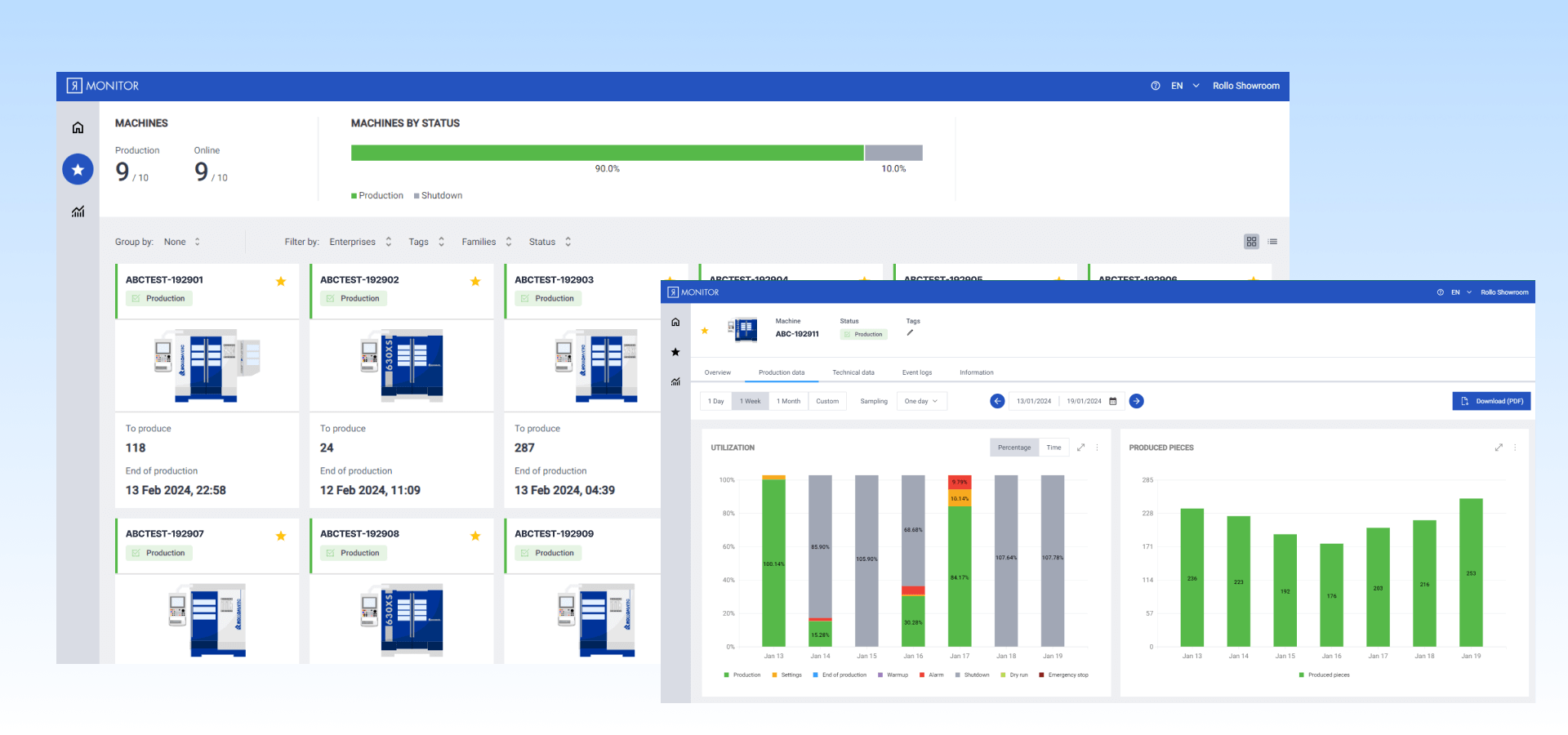
RMonitor web application allows buyers to monitor the status of machine production and performance in real time.

Discovery
Discovery is an analysis and planning phase that helps your tech team study all important aspects of the project before developing a supplier management portal.
- Understand your current vendor management process, analyze your business goals and challenges, and translate them into project objectives.
- Analyze existing infrastructure, solutions, integrations, and in-house systems that will connect with the portal (ERP, CMS, CRM, PIM, etc.).
- Analyze technical requirements and limitations and choose tech stack (backend programming languages, frontend programming
- languages, cloud storage, and database solutions, etc.).
- Conduct market research (target audience, competition, domain best practices).
- Gather, document, and prioritize requirements and define the scope.
- Create product roadmap and delivery timeline.
Design
Design determines how users will navigate and complete tasks on a portal. When you make a custom vendor portal, the design team breaks down your unique business process into scenarios and workflows and creates user experience and interface design based on your business flow. They also put together the rules for responsive design and design system.
Just like other B2B portals, vendor portals usually have dynamic dashboards and involve manipulation with large volumes of data in various forms — vendor databases, product listings, rate cards, performance diagrams, etc. So the design team needs to come up with a convenient and simple-to-use navigation, color codes, filters and drill through features, and dashboard reports that will help users to effectively complete their tasks.
Development
The development team sets up the environment and implements the functionality and features of a portal. Along with actual coding, this phase involves:
- Integration with in-house systems and components (integration with ERP, CMS, CRM, PIM, databases, and other systems).
- Web portal integration with third-party components (payment systems, customer support, shipping, order tracking).
- Implementation and testing of non-functional requirements (performance, security, stability, scalability).
- Comprehensive testing and debugging during each iteration.
Move to seamless vendor management
Create a custom-built vendor portal to enrich your portfolio and secure your supply chain.
Develop a vendor portalDeployment and support
Once the development and testing are complete and your portal is A-OK to go live, it is deployed to the production environment. The development team makes sure the portal performs as it should. But the job doesn’t end here. Maintenance and ongoing support are just as important to keep a portal up-to-date and technically sound.
Mind that support and maintenance may seriously impact the overall cost of your portal. So you should consider it early doors when you still choose between making a custom vendor portal or a platform-based solution. In the next section, we talk about how to make the right choice and avoid inflating the costs of web portal development.
Here are the proven tips from senior tech expert and Digiteum co-founder Katherine Lazarevich that will help you choose the right approach to building a vendor portal.
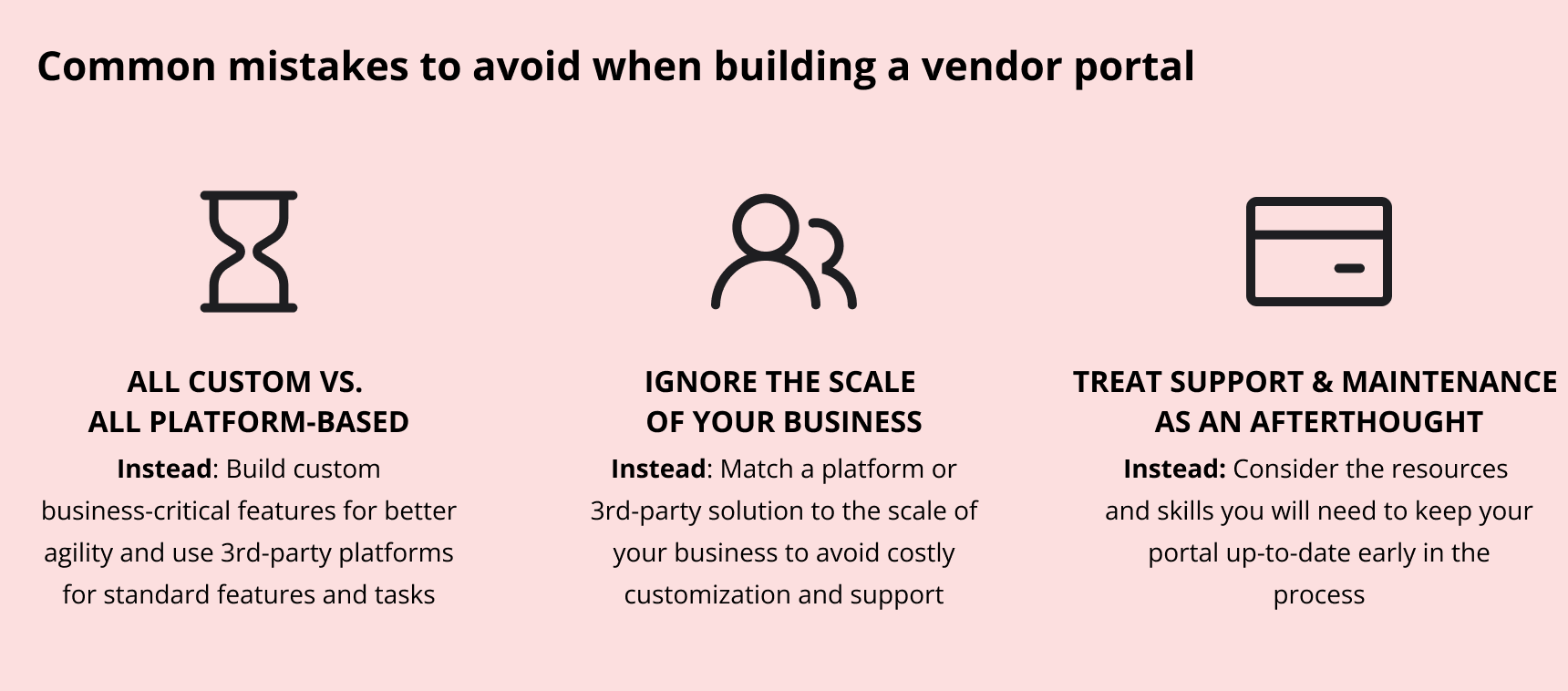
All custom vs. all platform-based
You can build a custom web portal from scratch, or you can choose an industry-proven platform and customize it for your needs. But in many cases, the truth is the middle. Because platform-based development may lock you in one solution and limit your business opportunities, making large-scale customization too costly and resource-consuming. On the other hand, developing everything from zero may pull too much money from your budget you would rather use on your core functionality.
It’s important to analyze your business and tech requirements and single out business-critical and secondary features. If your business-critical features don’t match the capabilities of a platform-based solution, create a custom workflow that precisely matches your business needs. And then choose third-party platforms and libraries for standard features (customer support, shipping tracking) to cut down on development costs.
Ignore the scale of your business
When you plan your product development, make sure that the scale of a platform or third-party solutions you choose fits the scale of your business. Otherwise, it may cost you too much to customize and support your solution. This happens, for example, when small or medium businesses choose enterprise-level platforms that come with huge package of modules and features they don’t need.
To do that, define realistic criteria to analyze existing solutions in the market and find the right match for your current and future business needs. Choose the solutions that are:
- able to complete the tasks you set,
- relevant to your scale, capacity, and budget, and
- maintainable and can easily integrate into your workflow.
Treat support and maintenance as an afterthought
As we’ve mentioned before, you should think of how you will support and maintain your system before you start creating a supplier management portal. As a rule, off-the-self solutions are supported and updated regularly by service providers. If you opt for custom portal development, take into consideration the resources and skills you will need to keep your portal up-to-date.
A reputable vendor portal development company will analyze your business goals and requirements and select the right approach and solutions that will help you save development costs and time.
Digiteum is an IT company with a strong focus on web development and over a decade of successful deliveries for companies in logistics, retail, healthcare, HR, travel, and other industries. We will help you work out the right strategy for supplier portal development. Whether you look for modernizing and reengineering an existing procurement portal or develop a new system for your business, we offer:
- Business-first approach, product strategy, and IT consulting (including scoping workshops and discovery).
- End-to-end web portal design and development.
- Senior design and engineering teams and rich tech stack (.NET, Java, Angular, React, Python, Node.js, AWS, MS Azure, Google Cloud, etc.)
- Proven portfolio of successful deliveries for such clients as Oxford University Press, Printique, Lodgify, Origin Digital, Oracle UK, and more.
- ISO-certified services, compliant data management and delivery practices (ISO 27001, ISO 13485, ISO 9001).
- Top software developers and UX specialists for supply chain, logistics, and transport according to Clutch.
Create a resilient supply chain
Promote faster decision-making and better risk management with a quality vendor portal.
HIRE PORTAL DEVELOPERSShort wrap-up
-
- Businesses across all major industries from manufacturing to retail and hospitality adopt vendor portals and create custom vendor management solutions to automate procurement operations, simplify vendor onboarding, and ensure supply chain continuity.
- There are several approaches to build a custom supplier portal that fit different businesses depending on their scale, goals, and resources.
- Choosing the right development strategy, integrations, and third-party solutions mitigates the risks of going over budget and timelines.
This post was originally published on May 1, 2023 and updated on December 20, 2024.
FAQ
- Start with an in-depth analysis of your business workflow and goals to decide on the development strategy and the choice of platforms and tools.
- Opt for third-party integrations and modules to solve standard tasks (customer support, shipping tracking).
- Choose solutions that match the scale of your business and operations.
- Consider support and maintenance at the planning stage.







